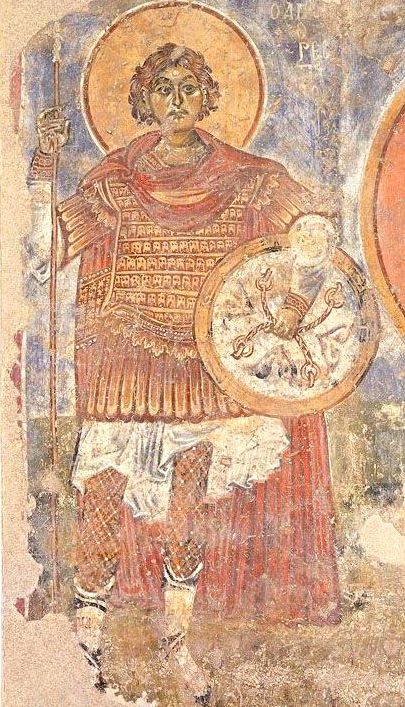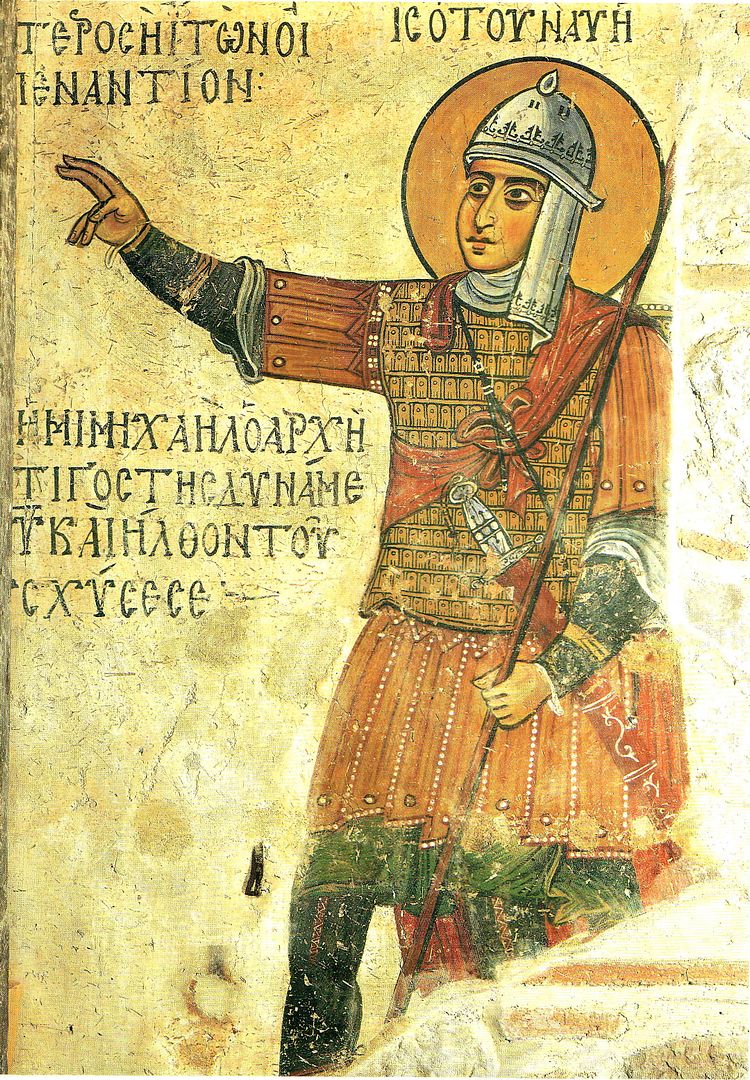Jack Loomes
Swordsperson
C.E.O. Sword-Site
Posts: 1,770 
|
Post by Jack Loomes on Mar 8, 2015 9:28:58 GMT
 Another fresco depicting the betrayal of J.C. On the left is a dagger, and on the right a short sword. Short swords appear to have been in continuous use in the Byzantine Army and are depicted right up until the fall of Constantinople. This example shows military clothing which might indicate that the mural was painted at the very end of the Byzantine Period. |
|
Jack Loomes
Swordsperson
C.E.O. Sword-Site
Posts: 1,770 
|
Post by Jack Loomes on Mar 8, 2015 9:32:44 GMT
 Long slender swords were a favourite of the Eastern Romans. Thin or narrow bladed swords appear to have caught on in Constantinople and the lands of the Romiosi, as well as in Spain (perhaps independently) well before they became popular in Northern Europe. Why this was is likely to be mere speculation unless some tangible evidence makes itself known, though the long standing Roman tradition of emphasising the thrust over the cut may have been a force driving this development. |
|
Jack Loomes
Swordsperson
C.E.O. Sword-Site
Posts: 1,770 
|
Post by Jack Loomes on Mar 8, 2015 9:47:57 GMT
 A Fresco of Saint Aristus / Orestes / Horeste / Odistus. No sword but the fresco is a relevant contribution as Saint Odistus is wearing an extremely well replicated cuirass of Byzantine lamellar armour. |
|
Jack Loomes
Swordsperson
C.E.O. Sword-Site
Posts: 1,770 
|
Post by Jack Loomes on Mar 14, 2015 2:05:58 GMT
 Date: probably late 14th century Culture: Byzantine Medium: Sardonyx Dimensions: Overall: 1 1/8 x 13/16 x 3/16 in. (2.8 x 2.1 x 0.4 cm) Classification: Lapidary Work-Sardonyx Credit Line: The Milton Weil Collection, 1940 Accession Number: 40.20.58 This small oval cameo, which probably depicts the archangel Michael, was once most likely set into a metal frame to be worn suspended from its owner's neck. The cameo almost certainly served an apotropaic function, and Michael's role as the commander of the angelic host, a miraculous healer, and psychopompos (conductor of souls) would make his depiction on a phylactery a logical choice. The artist has skillfully used the material to contrast the low white relief of the saint against the rich dark red background of the matrix. The archangel is seen standing upon a suppedaneum (footstool). Dressed in full military costume, he grasps his sword sheath with his left hand and holds his sword upright with his right. This emphasis on Michael's martial role is noteworthy, for depictions of the saint more frequently show him wearing a chiton and himation. This choice may indicate the patronage of a member of the Byzantine military aristocracy. Instead of gazing intently at the viewer, the archangel focuses his gaze to the right, which gives an impression of vigilance and prevents a sense of stasis from dominating the composition. The artist has further underscored that the figure is not in absolute repose by positioning the right wing to indicate that Michael has just alighted; the same narrative detail is seen in the figure of the archangel Gabriel in a fourteenth-century icon of the Annunciation, now in Skopje. This attempt at creating a sense of movement and the figure's incongruously wide hips (a feature also seen in steatite carving) both suggest an attribution to the fourteenth century. Source: www.metmuseum.org/collection/the-collection-online/search/467685 |
|
Jack Loomes
Swordsperson
C.E.O. Sword-Site
Posts: 1,770 
|
Post by Jack Loomes on May 15, 2016 10:17:05 GMT
 Byzantine fresco as previously shown but in far greater definition. |
|
Jack Loomes
Swordsperson
C.E.O. Sword-Site
Posts: 1,770 
|
Post by Jack Loomes on May 15, 2016 10:28:55 GMT
|
|
Jack Loomes
Swordsperson
C.E.O. Sword-Site
Posts: 1,770 
|
Post by Jack Loomes on May 16, 2016 13:21:30 GMT
 Roman / Byzantine Swordsmen. Ivory, 6th Century. Note that the Swordsmen and Spearman are poised in what are probably archetypal battle stances for contemporary Roman Soldiers. The swordsmen stand shield forward with sword well behind the body. This is likely to enable a number of attacks, probably many of which were preceded by a shield punch or block. Following this would have likely been a thrust into the opponent's collar bone and down, a diagonal slash across the opponent (probably focused on the shin), a right to left slash or a number of other forms of attack. The spearman stands with spear held in a time honoured position that allows for strikes to the solar plexus and face. Source: en.wikipedia.org/wiki/File:Roman_swordsman.jpg |
|
Jack Loomes
Swordsperson
C.E.O. Sword-Site
Posts: 1,770 
|
Post by Jack Loomes on May 16, 2016 13:30:43 GMT
 Clash between Byzantines and Arabs at the Battle of Lalakaon (863) and defeat of Amer, the Emir of Malatya. The similarity in armies is not due to naiveté on the behalf of the illustrator - Islamic Armies in particular emulated the panoply and military practices of the Byzantines, and for this reason Byzantines found them to be problematic adversaries. Note that single edged swords appear to be in use as well as double edged swords, many of the single edged swords are of the 'Avar' type. Chronicle of John Skylitzes, cod. Vitr. 26-2, fol. 73va, Madrid National Library 13th Century Source: en.wikipedia.org/wiki/File:Fighting_between_Byzantines_and_Arabs_Chronikon_of_Ioannis_Skylitzes,_end_of_13th_century..jpg |
|
Jack Loomes
Swordsperson
C.E.O. Sword-Site
Posts: 1,770 
|
Post by Jack Loomes on Aug 11, 2020 12:47:42 GMT
 Saint Georges & Saint Dimitri. XIth / XIIth c. found 1894, Chersonesos. Tauride (Crimea now). Carved slate. |
|
.png?width=1920&height=1080&fit=bounds)